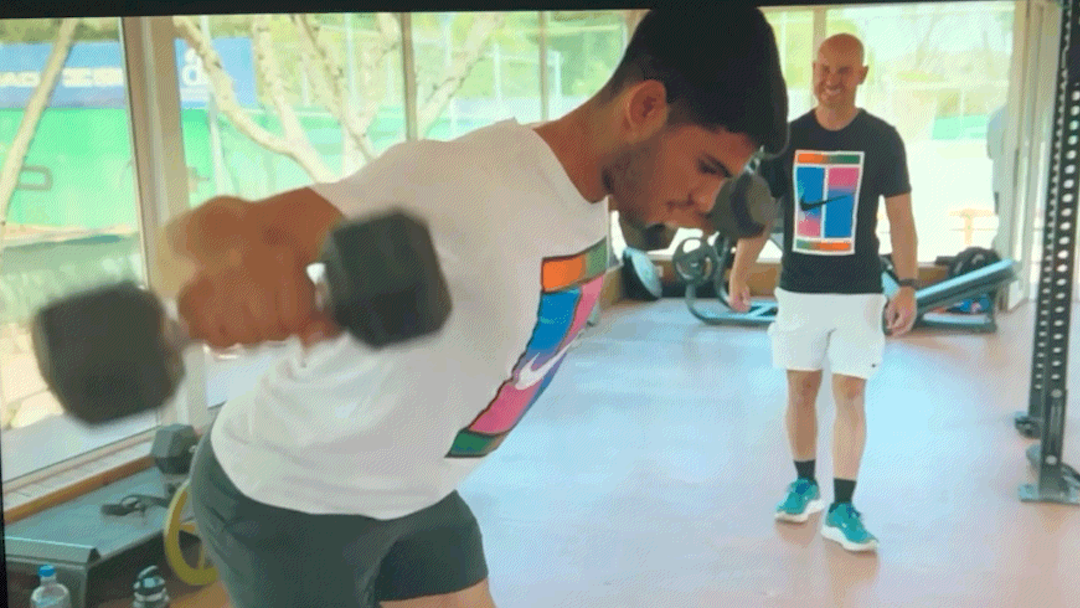Using chalk on a tennis court surface is highly discouraged because it can cause long-term damage and affect playability. Chalk can embed itself into the porous surface of hard courts, leading to discoloration and making the court harder to clean. On a couple of occasions, I have encountered players who want to use chalk to keep track of the score. Frankly, I prefer to just regularly announce the score at regular intervals.
In the fall of 2021, I played a practice match at a local area high school where someone had chalk-marked stations around the sides of the court for cardio fitness circuits. While I don’t want to encourage or glorify defacing tennis courts in this way, the stations themselves were intriguing. Consequently, I am in the process of breaking down the exercise at each station in a short series of posts. Today’s station was simply labeled “Squats.” There are a lot of good variations of squats that are good for tennis, but given the context, I am assuming the intent was the basic body weight variation.
Squats are a foundational exercise for tennis players and a key component of any well-rounded training program. This versatile movement engages many of the muscles critical for on-court performance while mimicking the functional motion required to lower the body closer to the court for hitting groundstrokes. Squats primarily target the glutes and quadriceps, which are essential for explosive movements such as sprinting, lunging, and jumping. Additionally, they activate the hamstrings, calves, and core muscles, which are all essential for balance and stability. Performing squats improves a player’s ability to generate power. It is a tennis-specific powerhouse exercise.
In fitness-related pop culture, tennis players have been used as models for the benefits of squats. For example, Andre Aggassi’s trainer Gil Reyes shaded a “secret strategy” in a 2010 Men’s Health feature. That article indicated that Agassi’s routine included three sets of ten squats performed with an 80-pound barbell resting on his shoulders. More recently, that same magazine ran a workout feature on Andy Murray, that also included squats. While the weight was unspecified, Murray indicated that he performs six sets of five reps and that he uses a squat rack. Both factors are a pretty good sign that he lifts more than 80 points that Agassi uses.
Right now, I have two variations of squats on heavy rotation in my fitness routine. I have been performing deep sumo body-weight squats with the feet wider than shoulder-width apart and toes pointed outward at about a 30-45 degree angle. I typically do three sets of ten and bring my butt all the way down to the heels for a full range of motion. I have to use a yoga strap for stability due to a limited range of motion in my ankles, but this exercise helps improve that. The deep squat maximizes glute activation and also enhances hip and groin flexibility.
The other squat in heavy rotation us to perform standard depth squats while holding a weighted medicine ball in front of my chest. That variation adds a little more challenge while disrupting balance, similar to on-court tennis movements. Though I rarely perform this variation, a tennis workout feature that ran in the Wall Street Journal in 2021 recommends combining squats with a weighted overhead press for the same effect.
Squats are a potential game-changer for your tennis performance. The exercise offers a functional foundation that translates directly to the court and prepares your body for the demands of the game. If you are not already performing squats on the regular, you should seriously consider incorporating them into your fitness routine. It can only enhance tennis performance.
- Andre Agassi’s Workout, Amy Levin-Epstein, Men’s Health, October 5, 2010.
- Andy Murray’s Strength Workout, Men’s Health, May 5, 2018.
- Eight Exercises to Build Power and Improve Your Tennis Game, Jen Murphy, The Wall Street Journal, August 28, 2021.



